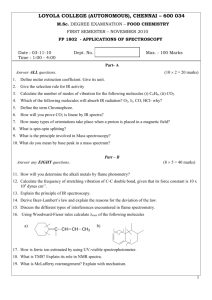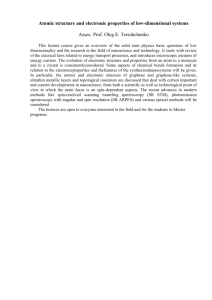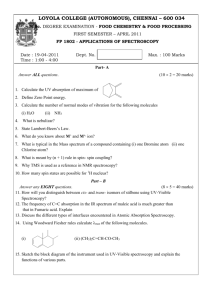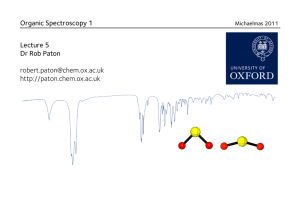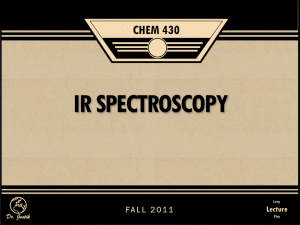CH 4809 - Loyola College
advertisement
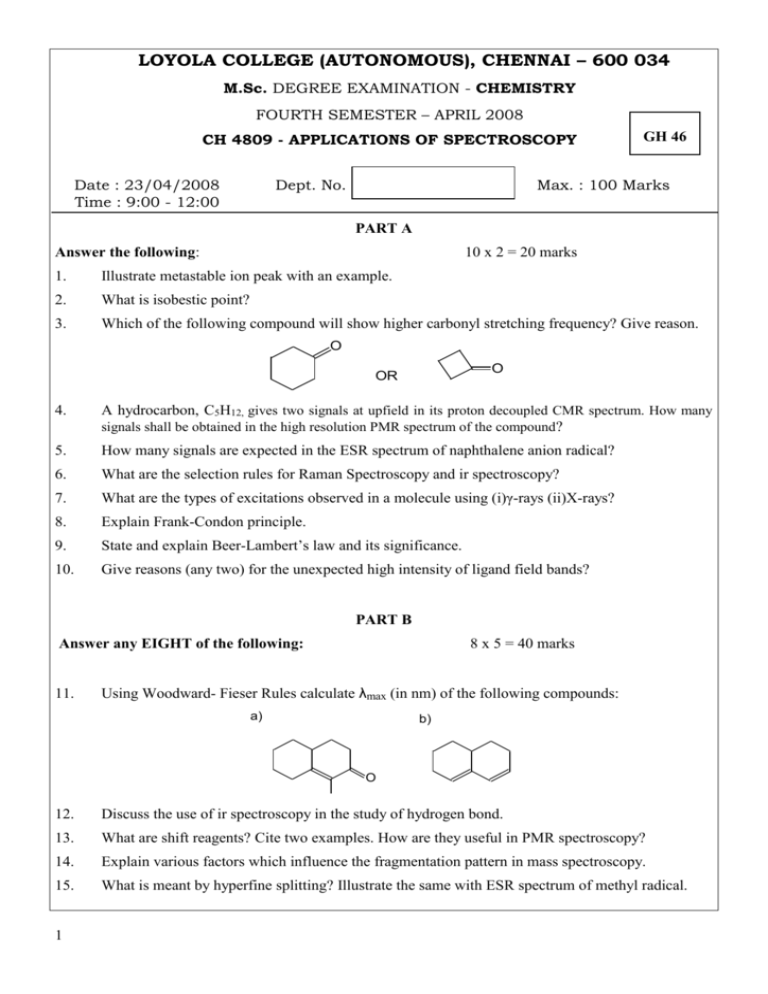
LOYOLA COLLEGE (AUTONOMOUS), CHENNAI – 600 034 M.Sc. DEGREE EXAMINATION - CHEMISTRY FOURTH SEMESTER – APRIL 2008 CH 4809 - APPLICATIONS OF SPECTROSCOPY Date : 23/04/2008 Time : 9:00 - 12:00 Dept. No. GH 46 Max. : 100 Marks PART A Answer the following: 10 x 2 = 20 marks 1. Illustrate metastable ion peak with an example. 2. What is isobestic point? 3. Which of the following compound will show higher carbonyl stretching frequency? Give reason. O O OR 4. A hydrocarbon, C5H12, gives two signals at upfield in its proton decoupled CMR spectrum. How many signals shall be obtained in the high resolution PMR spectrum of the compound? 5. How many signals are expected in the ESR spectrum of naphthalene anion radical? 6. What are the selection rules for Raman Spectroscopy and ir spectroscopy? 7. What are the types of excitations observed in a molecule using (i)γ-rays (ii)X-rays? 8. Explain Frank-Condon principle. 9. State and explain Beer-Lambert’s law and its significance. 10. Give reasons (any two) for the unexpected high intensity of ligand field bands? PART B Answer any EIGHT of the following: 11. 8 x 5 = 40 marks Using Woodward- Fieser Rules calculate λmax (in nm) of the following compounds: a) b) O 12. Discuss the use of ir spectroscopy in the study of hydrogen bond. 13. What are shift reagents? Cite two examples. How are they useful in PMR spectroscopy? 14. Explain various factors which influence the fragmentation pattern in mass spectroscopy. 15. What is meant by hyperfine splitting? Illustrate the same with ESR spectrum of methyl radical. 1 16. From the provided data of a compound, deduce its structure: Molecular formula: C8H8O2 IR, ν, cm-1 (important bands only): 3000- 2500(broad); 1710(s). 1 H NMR, δ, ppm: 7.2(5H, s); 11.6(1H, s); 3.5(2H, s) 17. What are tetragonal distortions? 18. How does geometry of a molecule influence rates of substitution reactions of coordination compounds? 19. Why does KMnO4 have high intense colour, while Mn(II) complexes show feeble colour? 20. Account for a shoulder observed in the electronic spectrum of [Ti(H2O)6]3+, despite it has d1 configuration 21. Explain the principle of NQR spectroscopy. 22. Explain sample handling in ir spectroscopy. PART C Answer any FOUR of the following: 23. 4 x 10 = 40 marks a) How are π → π* and n → π* transitions differentiated by solvent effects in UV spectroscopy? Explain with energy level diagram. b) Discuss the principle of EPR spectroscopy. 24. Write notes on (a) McLafferty rearrangement (b) Stevenson’s Rule. 25. An organic compound has molecular formula C10H13NO2, and its significant spectral features are as follows: UV, λmax (EtOH): K- Band appears at 290nm IR, 1 ν cm-1 : 3402(s); 3318(s); 3025(s); 1695(s); 1580(s); 1580(m) HNMR, δ, ppm:7.9(2H,d);6.7(2H,d); 4.75(1H,septet); 4.2(2H, broad); 1.25(6H,d) Assign suitable structure to the compound and account for the spectral data. 26. Give a detailed account of CT and LF bands of coordination compounds and their usefulness. 27. Explain term symbols, taking d1 electronic configuration as example. Also show how the terms get split in the presence of ligand field using Orgel and Tanabe-Sugano diagrams. Compare the properties of these diagrams and applications 28. Explain the use of (a) ESR spectroscopy in proving the covalency in M-L bonds; (b) Mössbauer spectroscopy for inorganic compounds. ****************** 2

